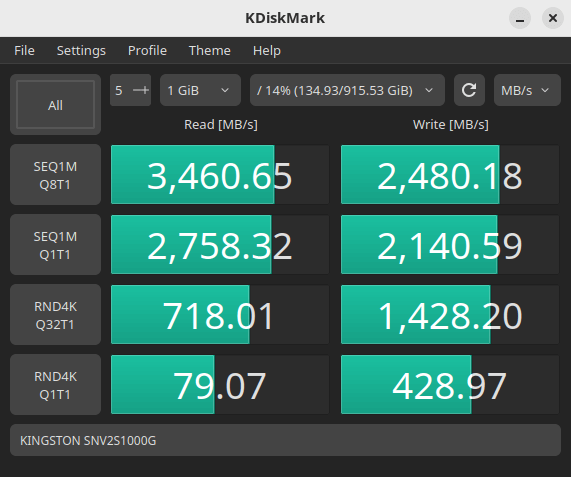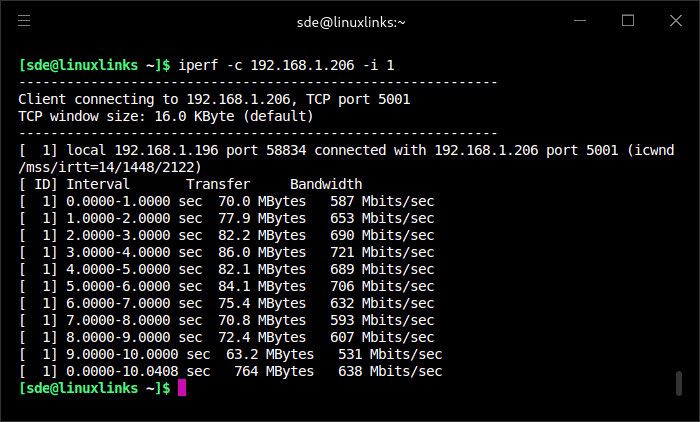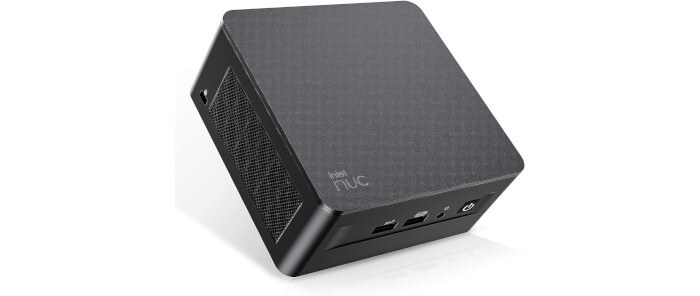Disk Benchmark
Our NUC has this 1TB Kingston NVMe.

We tested the drive with KDiskMark, a free and open source graphical frontend to Flexible I/O. The software provides an easy to view and interpret comprehensive benchmark result.
Here are the results for the 1TB NVMe.

The performance is in line with Kingston’s claimed read/write speeds up to 3,500/2,800MB/s. For the vast majority of users, its speed and storage capacity for an NVMe will be perfect and sufficient for many years. It’s also a big improvement to a system’s responsiveness if you’re used to a SATA SSD or mechanical disk.
The Kingston disk is a Gen 4×4 NVMe PCIe, but its performance is similar to many Gen 3×4 drives. And it doesn’t have a DRAM chip.
There are faster Gen 4×4 NVMe PCIe available, some which include a DRAM chip. The good news is that as the NUC has a Gen 4×4 NVMe controller, you can always replace the Kingston drive with a faster (and larger) drive in the future if necessary.
WiFi
We generally prefer network connections over ethernet rather than Wi-Fi. And the NUC has an Intel 2.5Gb Ethernet Controller i226-V. That’s a big advantage. 1G ethernet controllers are still commonly included with budget motherboards.
But Wi-Fi does has some advantages over ethernet. There’s no wire clutter, and you can connect anywhere in your home. Almost all modern devices can connect to Wi-Fi from desktops to smartphones. And you can have many devices connected and streaming simultaneously.
The NUC has Intel Wi-Fi 6E AX211 (Gig+). We connected its Wi-Fi to a Technicolor 4134 (Wi-Fi 6) router.
To test typical day-to-day performance, we placed the NUC on a different floor to our router. That’s intended to mirror a fairly representative setup for home Wi-Fi systems where it’s not convenient to locate a PC fairly close to the router.
Here are performance statistics using the iperf utility. The local machine (IP 192.168.1.206) is connected to the router via wired ethernet.

The transfer rate is superb given the distance and walls between the NUC and our router. Typically, modern laptops average transfers around 400-550 Mbits/sec in the same location, which is surpassed by the NUC.
Next page: Page 5 – Specifications
Pages in this article:
Page 1 – Introduction / System
Page 2 – Processor
Page 3 – Memory / Graphics
Page 4 – Disk / WiFi
Page 5 – Specifications
Complete list of articles in this series:
| Intel NUC 13 Pro Mini PC | |
|---|---|
| Part 1 | Introduction to the series with interrogation of system |
| Part 2 | Benchmarking the Mini PC |
| Part 3 | Installing Ubuntu 23.10 Desktop |
| Part 4 | Configuring Ubuntu 23.10 Desktop |
| Part 5 | Power Consumption |
| Part 6 | P-Cores and E-Cores |
| Part 7 | Gaming |
| Part 8 | Installing and Configuring Manjaro |
| Part 9 | BIOS options |

How does the i7-1360P compare with the latest Ryzen chips e.g. 7600X.
Which chip offers the best performance over cost in a mini-pc?
We don’t have the 7600X chip, but other sites indicate performance is almost identical to the i7-1360P. And factor in the TDP of the 7600X is 105W which needs serious cooling.
Would be great if you could do a comparison with a Ryzen-based mini-pc.
Yes, I’d love to do comparisons with AMD CPUs, but I don’t have any.